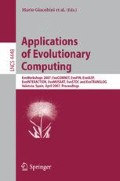Abstract
We describe a novel method of evolutionary visual learning that uses generative approach for assessing learner’s ability to recognize image contents. Each learner, implemented as a genetic programming individual, processes visual primitives that represent local salient features derived from a raw input raster image. In response to that input, the learner produces partial reproduction of the input image, and is evaluated according to the quality of that reproduction. We present the method in detail and verify it experimentally on the real-world task of recognition of hand-drawn shapes.
Access this chapter
Tax calculation will be finalised at checkout
Purchases are for personal use only
Preview
Unable to display preview. Download preview PDF.
References
Bhanu, B., Lin, Y., Krawiec, K.: Evolutionary Synthesis of Pattern Recognition Systems. Springer-Verlag, Berlin Heidelberg New York (2005)
Krawiec, K., Bhanu, B.: Visual learning by coevolutionary feature synthesis. IEEE Transactions on System, Man, and Cybernetics – Part B. 35, 409–425 (2005)
Krishnapuram, B., Bishop, C.M., Szummer, M.: Generative models and bayesian model comparison for shape recognition. In: IWFHR 2004. Proceedings of the Ninth International Workshop on Frontiers in Handwriting Recognition, pp. 20–25. IEEE Computer Society, Washington, DC, USA (2004)
Koza, J.: Genetic programming – 2. MIT Press, Cambridge, MA (1994)
Jaskowski, W.: Genetic programming with cross-task knowledge sharing for learning of visual concepts. Master’s thesis, Poznan University of Technology, Poznań, Poland (2006)
Wieloch, B.: Genetic programming with knowledge modularization for learning of visual concepts. Master’s thesis, Poznan University of Technology, Poznań, Poland (2006)
Teller, A., Veloso, M.: PADO: A new learning architecture for object recognition. In: Ikeuchi, K., Veloso, M. (eds.) Symbolic Visual Learning, pp. 77–112. Oxford Press, New York (1997)
Rizki, M., Zmuda, M., Tamburino, L.: Evolving pattern recognition systems. IEEE Transactions on Evolutionary Computation 6, 594–609 (2002)
Maloof, M., Langley, P., Binford, T., Nevatia, R., Sage, S.: Improved rooftop detection in aerial images with machine learning. Machine Learning 53, 157–191 (2003)
Olague, G., Puente, C.: The honeybee search algorithm for three-dimensional reconstruction. In: Rothlauf, F., Branke, J., Cagnoni, S., Costa, E., Cotta, C., Drechsler, R., Lutton, E., Machado, P., Moore, J.H., Romero, J., Smith, G.D., Squillero, G., Takagi, H. (eds.) EvoWorkshops 2006. LNCS, vol. 3907, pp. 427–437. Springer, Berlin Heidelberg New York (2006)
Howard, D., Roberts, S.C., Ryan, C.: Pragmatic genetic programming strategy for the problem of vehicle detection in airborne reconnaissance. Pattern Recognition Letters 27, 1275–1288 (2006)
Krawiec, K.: Learning high-level visual concepts using attributed primitives and genetic programming. In: Rothlauf, F., Branke, J., Cagnoni, S., Costa, E., Cotta, C., Drechsler, R., Lutton, E., Machado, P., Moore, J.H., Romero, J., Smith, G.D., Squillero, G., Takagi, H. (eds.) EvoWorkshops 2006. LNCS, vol. 3907, pp. 515–519. Springer-Verlag, Berlin Heidelberg New York (2006)
Krawiec, K.: Evolutionary learning of primitive-based visual concepts. In: Proc. IEEE Congress on Evolutionary Computation, Sheraton Vancouver Wall Centre Hotel, Vancouver, BC, Canada, pp. 4451–4458 (July 16-21, 2006)
Revow, M., Williams, C.K.I., Hinton, G.E.: Using generative models for handwritten digit recognition. IEEE Transactions on Pattern Analysis and Machine Intelligence 18, 592–606 (1996)
Luke, S.: ECJ evolutionary computation system (2002) (http://cs.gmu.edu/ eclab/projects/ecj/)
Author information
Authors and Affiliations
Editor information
Editors and Affiliations
Rights and permissions
Copyright information
© 2007 Springer-Verlag Berlin Heidelberg
About this paper
Cite this paper
Jaśkowski, W., Krawiec, K., Wieloch, B. (2007). Learning and Recognition of Hand-Drawn Shapes Using Generative Genetic Programming. In: Giacobini, M. (eds) Applications of Evolutionary Computing. EvoWorkshops 2007. Lecture Notes in Computer Science, vol 4448. Springer, Berlin, Heidelberg. https://doi.org/10.1007/978-3-540-71805-5_31
Download citation
DOI: https://doi.org/10.1007/978-3-540-71805-5_31
Publisher Name: Springer, Berlin, Heidelberg
Print ISBN: 978-3-540-71804-8
Online ISBN: 978-3-540-71805-5
eBook Packages: Computer ScienceComputer Science (R0)

